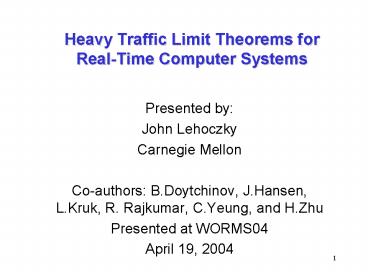Heavy Traffic Limit Theorems for RealTime Computer Systems - PowerPoint PPT Presentation
Title:
Heavy Traffic Limit Theorems for RealTime Computer Systems
Description:
to predict the fraction of the workload that will miss its deadlines (end-to-end ... to design workload scheduling and control policies that will ensure QoS ... – PowerPoint PPT presentation
Number of Views:68
Avg rating:3.0/5.0
Title: Heavy Traffic Limit Theorems for RealTime Computer Systems
1
Heavy Traffic Limit Theorems for Real-Time
Computer Systems
- Presented by
- John Lehoczky
- Carnegie Mellon
- Co-authors B.Doytchinov, J.Hansen, L.Kruk, R.
Rajkumar, C.Yeung, and H.Zhu - Presented at WORMS04
- April 19, 2004
2
Background 1
- Real-time systems refer to computer and
communication systems in which the
applications/tasks/jobs/packets have explicit
timing requirements (deadlines). - These arise in (e.g.)
- voice and video transmission (e.g.
video-conferencing) - control systems (e.g. automotive)
- avionics systems
3
Background 2
- We often distinguish different types of real-time
systems or tasks - Hard real-time any failure to meet a deadline
is regarded as a system failure. (e.g. avionics
or control systems) - Soft real-time deadline misses or packet loss is
acceptable as long as it doesnt reduce the QoS
below requirements (e.g. multi-media
applications).
4
Goals
- For a given workload model we want
- to predict the fraction of the workload that
will miss its deadlines (end-to-end deadlines in
the network case), - to design workload scheduling and control
policies that will ensure QoS guarantees (e.g. a
suitably small fraction miss their deadlines), - to investigate network design issues, e.g.
- Number of priority bits needed
- Cost/benefit from flow tables
- Cost/benefit from keeping lead-time information
5
Formulation
- In the hard real-time formulation where no
deadlines misses are permitted, one must adopt a
worst case formulation - task arrivals occur as soon as possible,
- task services take on their maximum values,
- task deadlines are as short as possible.
- One must bound the worst case utilization.
- But it average case utilization is substantially
less than worst case utilization, the system
will, on average, be highly underutilized.
6
(No Transcript)
7
(No Transcript)
8
Model
- Multiple streams in a multi-node acyclic network.
- Independent streams of jobs.
- Jobs in a stream form a renewal process and have
independent computational requirements at each
node - For a given stream, each job has an i.i.d.
deadline (different for different streams) - Node processing is EDF (Q-EDF), FIFO, PS, HOL-PS,
Fixed Priority.
9
(No Transcript)
10
(No Transcript)
11
Analysis 1
- In addition to tracking the workload at each
node, we need to track the lead-time ( time
until deadline elapses) for each task. - The dimensionality becomes unbounded, and exact
analysis is impossible. - We resort to a heavy traffic analysis. This is
appropriate for real-time problems. If we can
analyze and control under heavy traffic, moderate
traffic will be better.
12
Analysis 2
- Heavy traffic analysis (traffic intensity on each
node converges to 1) - One node workload converges to Brownian motion.
Multiple nodes, workload may converge to RBM
(depending upon scheduling policy). - Conditional on the workload, lead-time profile
converges to a deterministic form depending upon - flow deadline distributions,
- scheduling policy
- traffic intensity
- Combining the lead-time profile with the
equilibrium distribution of the workload process,
we can determine the lateness fraction for each
flow.
13
Processor Sharing Exp. Deadlines
14
Processor Sharing Exp. Deadlines
15
Processor Sharing Exp. Deadlines
16
Processor Sharing Exp. Deadlines
17
Processor SharingConst. Deadlines
18
Processor Sharing-Const. Deadlines
19
Processor Sharing-Const. Deadlines
20
(No Transcript)
21
(No Transcript)
22
(No Transcript)
23
(No Transcript)
24
(No Transcript)
25
(No Transcript)
26
EDF Miss Rate Prediction
EDF Deadline Miss Rate
?0.95 EDF scheduling Uniform(10,x) deadlines
Internet
Exponential
? computed from the first two moments of task
inter-arrival times and service times.
Mean Deadline
Uniform
27
Motivation/Payoff
CPU 1
CPU 2
Server 1
Server 4
Server 1.1
Stream 1
FIFO
FIFO
FIFO
Server 2
Server 5
Stream 2
FIFO
FIFO
Server 3
Server 6
Stream 3
Stream 4
FIFO
FIFO
28
(No Transcript)
29
(No Transcript)
30
(No Transcript)
31
(No Transcript)
32
(No Transcript)
33
(No Transcript)































